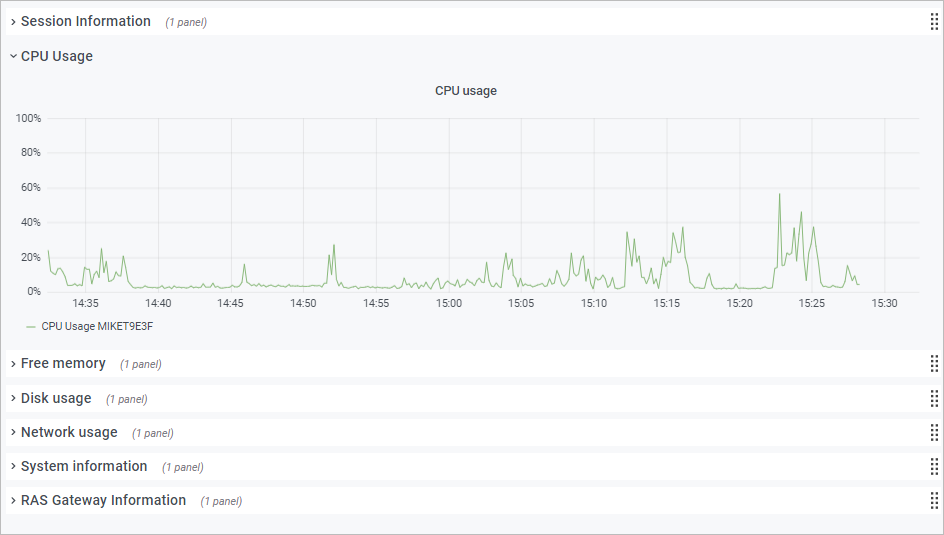Using Parallels RAS Performance Monitor
Configure access to Parallels RAS Performance Monitor
To enable data collection and view the dashboard:
- In the RAS Console, navigate to Administration > Reporting .
- Select the Enable RAS Performance Monitor option (the RAS Performance Monitor configuration section).
- Enter the FQDN or IP address of the server where you have the InfluxDB database and Grafana dashboard installed.
- Click Apply to commit the changes.
Once you perform the steps above, the Telegraf service is started on each server in the Site and the data collection begins.
Viewing performance metrics
To view performance metrics, select the Monitoring category in the RAS Console. The data is displayed in the right pane. The logon is performed automatically, so no logon credentials are required.
The buttons on the Monitoring tab (below the dashboard area) are as follows:
- Home . Displays the home page. The button is useful when you click on an external link in the dashboard, which may take you to an external web page.
- Refresh . Reloads the current page.
- Open in browser . Opens the performance dashboard in a web browser.
To view metrics of a specific type, expand the desired category in the main area of the dashboard. The categories include:
- Session Information . Displays the information about active sessions and disconnected sessions.
- CPU usage . CPU counters.
- Free memory . Physical memory counters.
- Disk usage . Disk I/O counters.
- Network usage . Network interface I/O counters.
- System information . System information counters.
- RAS Gateway information . RAS Gateway counters.
Performance metrics are displayed in the dashboard as a graph. Different counters are displayed using different colors.
To zoom in on a particular area of a graph, select a rectangular block with a mouse. You can also use the Zoom controls at the top of the dashboard for time range zoom out, shift time forward, or shift time backwards. To select a specific time range, click the "clock" icon at the top and then specify a time range.
By default, the dashboard opens in kiosk mode. To exist it, press "Esc". To cycle view mode, click the "monitor" icon in the upper right. When you exist kiosk mode, the RAS Infrastructure Health page is displayed:
The menu at the top has the following items:
- Hosts . Allows you to select one or multiple servers for which the performance metrics should be displayed. To display the data for all servers in the Site, select All . Please note that if you don't see any servers in the list, you need to wait for Parallels RAS Performance Monitor to collect the initial set of statistics. This only happens on initial installation.
- Instance . This item allows you to select a specific counter instance (if there's more than one). For Network counters it is usually the name of a network interface. For Disk counters it is a disk name. Other types of counters don't usually have multiple instances.
- Farm & Site . Select a Site for which to display the data. Selecting All displays the data for all sites in the Farm. If you have another RAS Farm, and the RAS Performance Monitor is configured and enabled in it, you can also select a Site from that Farm.
- Agent Type . Select a RAS agent type.
- Group . Select an RDS group.
For more information about performance metrics and their meaning, please refer to the following articles from Microsoft:
- https://technet.microsoft.com/en-us/library/cc976785.aspx
- https://technet.microsoft.com/en-us/library/2008.08.pulse.aspx
See also RAS Performance Counters .

